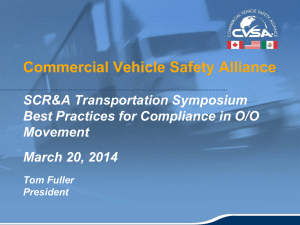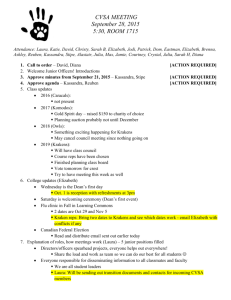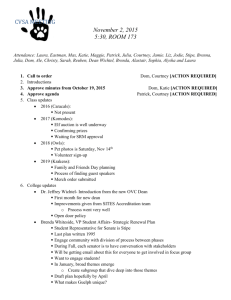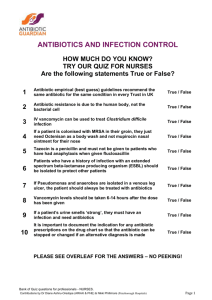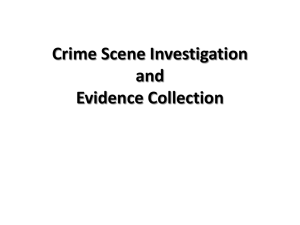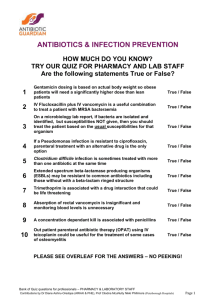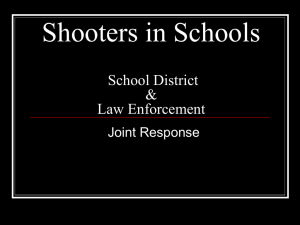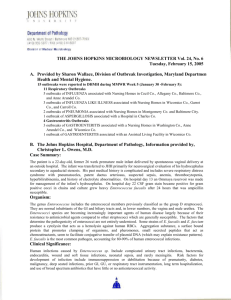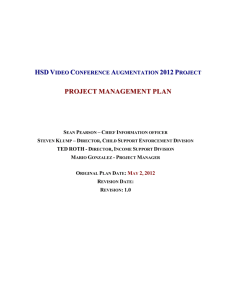chapter322601answers.. - www5555.morris.umn.edu
advertisement
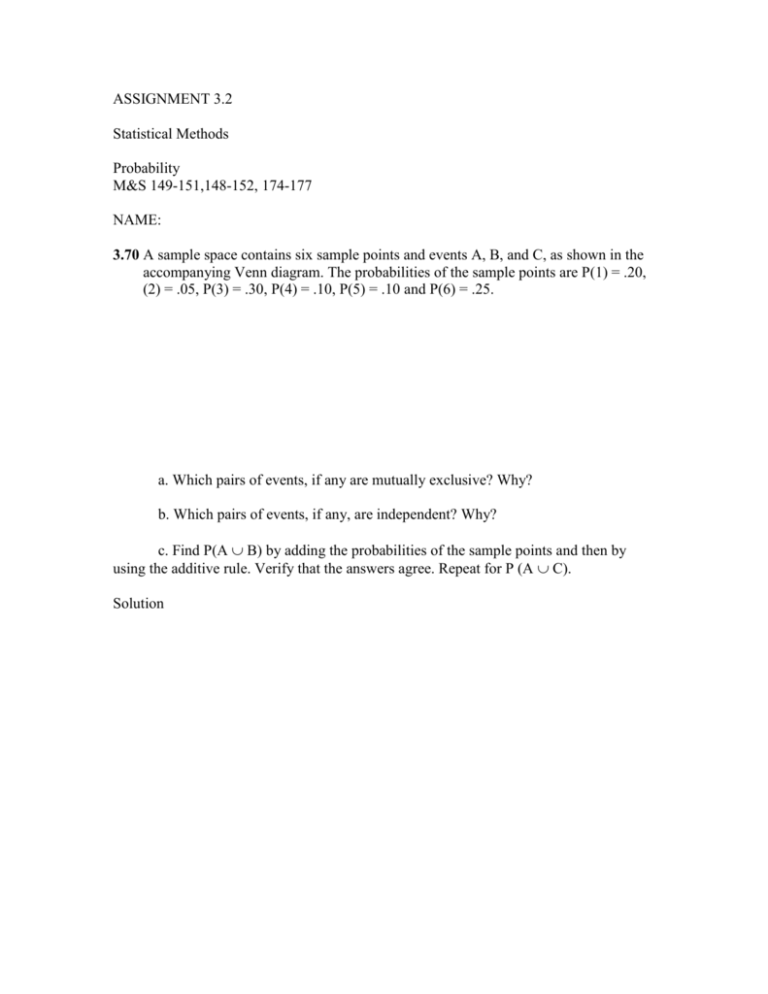
ASSIGNMENT 3.2
Statistical Methods
Probability
M&S 149-151,148-152, 174-177
NAME:
3.70 A sample space contains six sample points and events A, B, and C, as shown in the
accompanying Venn diagram. The probabilities of the sample points are P(1) = .20,
(2) = .05, P(3) = .30, P(4) = .10, P(5) = .10 and P(6) = .25.
a. Which pairs of events, if any are mutually exclusive? Why?
b. Which pairs of events, if any, are independent? Why?
c. Find P(A B) by adding the probabilities of the sample points and then by
using the additive rule. Verify that the answers agree. Repeat for P (A C).
Solution
3.84 Cigar smoking and cancer. The journal of the national Cancer Institute (Feb. 16,
2000) published the results of a study that investigated the association between cigar
smoking and death from tobacco-related cancers. Data were obtained for a national
sample of 137,243 American men. The results are summarized in the accompanying
table. Each male in the study was classified according to his cigar-smoking status
and whether or not he died from a tobacco-related cancer.
a. Find the probability that a randomly selected man never smoked cigars and died
from cancer.
b. Find the probability that a randomly selected man was a former cigar smoker and
died from cancer.
c. Find the probability that a randomly selected man was a current cigar smoker and
died form cancer.
d. Given that a male was a current cigar smoker, find the probability that he died
from cancer.
e. Given that a male never smoked cigars, find the probability that he died from
cancer.
Solution
3.63 For two events A and B, P(A) = .4, P(B) = .2 and P(A B) = .1
a. Find P(B/A)
b. Find P(A/B)
c. Are A and B independent events?
Solution
a. .25
b. .50
c. no
3.82 Requirements for high school graduation. In Italy, all high school students must
take a high school diploma (HSD) exam and write a paper in order to graduate. In
Organization Behavior and Human Decision Processes (July 2000), University of
Milan researcher L. Macchi provided the following information to a group of
college undergraduates. Fact 1: In Italy, 360 out of every 1,000 students fail their
HSD exam. Fact 2: Of those who fail the HSD, 75% also fail the written paper. Fact
3: Of those who pass the HSD, only 20 % fail the written paper. Define Events A
and B as follows:
A = {The student fails the HSD exam.}
B = { The student fails the written paper.}
a. Write fact 1 as a probability statement involving events A and/or B.
b. Write fact 2 as a probability statement involving events A and/or B.
c. Write fact 3 as probability statement involving events A and /or B.
d. State P(A B) in the words of the problem.
e. Find P(A B).
Solution
3.88 Lie detector test. A new type of lie detector called the Computerized Voice Stress
Analyzer (CVSA) has been developed. The manufacturer claims that the CVSA is
98% accurate and, unlike a polygraph machine, will not be thrown off by drugs and
medical factors. However, laboratory studies by the U.S. Defense Department found
that the CVSA had an accuracy rate of 49.8%, slightly less than pure chance.
(Tampa Tribune, Jan. 10, 1999.) Suppose the CVSA is used to test the veracity of
four suspects. Assume that the suspects’ responses are independent.
a. If the manufacturer’s claim is true, what is the probability that the CVSA will
correctly determine the veracity of all four suspects?
b. If the manufacturer’s claim is true, what is the probability that the CVSA will
yield an incorrect result for at least one of the four suspects?
c. Suppose that in a laboratory experiment conducted by the U.S. Defense
Department on four suspects, the CVSA yielded incorrect results for two of the
suspects. Make an inference about the true accuracy rate of the new lie detector.
Solution
3.162 Study of aggressiveness and birth order. Psychologists tend to believe that there
is a relationship between aggressiveness and order of birth. To test this belief, a
psychologist chose 500 elementary school students at random and administered
each a test designed to measure the student’s aggressiveness. Each percentages of
students failing into the four categories are shown here.
-------------------------------------------------------------------------------------------------Firstborn
Not Firstborn
--------------------------------------------------------------------------------------------------Aggressive
15%
15%
Not Aggressive
25%
45%
------------------------------------------------------------------------------------------------a. If one student is chosen at random from the 500, what is the probability that the
student is firstborn ?
b. What is the probability that the student is aggressive?
c. What is the probability that the student is aggressive, given that the student was
firstborn?
d. If we have
A: {The student chosen is aggressive.}
B: {The student chosen is firstborn.}
are A and B independent? Explain.
3.166 Antibiotic for blood infections. Enterococci are bacteria that cause blood
infections in hospitalized patients. One antibiotic used to battle enterococci is
vancomycin. A study by the Federal Centers for Disease Control and Prevention
reveal that 8% of all enterococcci isolated in hospitals nationwide were resistant to
vancomycin.(New york Times, Sept. 12, 1995). Consider a random sample of three
patients with blood infections caused by the enterococci bacterium. Assume that all
three patients are treated with the antibiotic vancomycin.
a. What is the probability that all three patients are treated successfully? What
assumption did you make concerning the patients.
b. what is the probability that the bacteria resist the antibiotic in at least one
patient?
Solution
3.169 Series and Parallel systems. Consider the two systems shown in the
accompanying schematic. System A operates properly only if all three components
operate properly. (The three components are said to operate in series.) The
probability of failure for system A components 1, 2, and 3 are .12, .09, and .11,
respectively. Assume that the components operate independently of each other.
System b comprises has two subsystems said to operate in parallel. Each
subsystem B will operate properly. The probability of failure for each component
in the system is .1. Assume that the components operate independently of each
other.
a. Find the probability that system A operates properly.
b. What is that probability that at least one of the components in systems A will
fail and therefore that the system will fail?
c. Find the probability that system B operates properly.
d. Find the probability that exactly one subsystem in System B fails.
e. Find the probability that System B fails to operate properly.
f. How many parallel subsystems like the two shown here would be required to
guarantee that the system would operate properly at least 99% of the time?
Solution
a. .7127
b. .2873
c. .9639
d. .3078
e. .0361
f. .at least 3
3.177 Accuracy of pregnancy tests. Seventy-five percent of all women who submit to
pregnancy tests are really pregnant. A certain pregnancy test gives a false positive
result with probability .02 and a valid positive result with probability .99. If a
particular woman’s test is positive, what is the probability that she really is
pregnant? [Hint: If A is the event that a woman is pregnant and B is the event that
the pregnancy test is positive, then B is the union of the two mutually exclusive
events A B and Ac B. Also, the probability of a false result may be written as
P(B/Ac) = .02.]
Solution
.993
